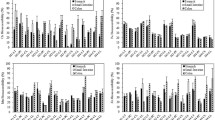Abstract
An in vitro gut model was used to investigate the bioavailability of calcium, magnesium, cadmium, chromium, iron, manganese, and lead in the Mexican (maize) tortilla. The samples (4 g) were digested in quartz tubes using concentrated nitric acid (12 mL) at 65‡C (2 h) and then at 120‡C (4 h). Total element concentration was determined by atomic absorption spectrometry. Enzymatic hydrolysis was carried out in two steps: first, with pepsin in a hydrochloric acid medium (pH 1.8) and then after neutralization with sodium bicarbonate (pH 6.0), with the mixture of pancreatine, amylase, and bile salts extract. Elements under study were determined in the supernatant by atomic absorption spectrometry. The bioavailable fraction of each element in tortilla was evaluated as the percentage of total element content found in the solution after enzymolysis. The obtained results showed relatively low bioavailability of the selected elements (from 2% to 32%), which possibly may be ascribed to the presence of dietary fiber in tortilla.
Similar content being viewed by others
References
S. Caroli, ed.,Element Speciation in Bioinorganic Chemistry, Wiley, New York (1996).
D. Behne, Speciation of trace elements in biological materials: trends and problems,Analyst 117, 555–557 (1992).
R. Cornelis, F. Borguet, and J. De Kimpe, Trace elements in medicine. Speciation: the new frontier,Anal. Chim. Acta. 283, 183–189 (1993).
H. T. Delves, C. E. Sieniawska, and B. Suchak, Total and bioavailable aluminum in foods and beverages,Anal. Proc. 30, 358–360 (1993).
R. E. Serfass, J. J. Thompson, and R.S. Houk, Isotope ratio determination by inductively coupled plasma mass spectrometry for zinc bioavailability studies,Anal. Chim. Acta 188, 73–84 (1986).
F. A. Mellon, J. Eagels, T. E. Fox, and S. J. Fairweather-Tait, Absorption and bioavailability studies of mineral nutrients by mass spectrometry,Anal. Chim. Acta. 283, 190–198 (1993).
P. B. Moser-Veillon, A. Reed Mangels, K. Y. Patterson, and C. Veillon, Utilization of two different chemical forms of selenium during lactation using stable isotope tracers: an example of speciation in nutrition,Analyst 117, 559–562 (1992).
M. Virta, J. Lampinen, and M. Karp, A luminescence-based mercury biosensor,Anal. Chem. 67, 667–669 (1995).
H. M. Crews, J. A. Burrell, and D. J. McWeeny, Trace-element solubility from food following enzymolysis,Z. Lebensm. Unters. Forsch. 180, 221–226 (1985).
L. G. Danielsson, A. Sparen, and A. Wichlund-Glynn, Aluminum fractionation in a simulated rat stomach: an in vitro study,Analyst 120, 713–720 (1995).
H. M. Crews, Chemical species go a la carte,Analy. Eur. 6, 28–31 (1995).
H. M. Crews, P. A. Clarke, D. J. Lewis, L. M. Owen, P. R. Strutt, and A. Izquierdo, Investigation of selenium speciation in in vitro gastrointestinal extracts of cooked cod by high-performance liquid chromatography-inductively coupled plasma mass spectrometry and electrospray mass spectrometry,J. Anal. Atomic Spectrom. 11, 1177–1182 (1996).
Analytical Methods for Atomic Absorption Spectrometry, Manual for a Model 3100 Pcrkin-Elmer, Perkin-Elmer.
L. E. Pantoja Villagómez, K. Wróbel, and K. Wróbel, Nitrato de magnesio como modificador quimico en la determinación de cadmio, cromo, hierro, plomo y selenio en aguas naturales por espectrometía de absorción atómica con horno de grafito,Bol. Soc. Chil. Quím. 43, 121–132 (1998).
E. Alvarez Cabal-Cimadevilla, K. Wróbel, J. M. Marchante-Gayón, and A. Sanz-Medel, Determination of chromium in biological fluids by electrothermal atomic absorption spectrometry using wall, platform and probe atomization from different graphite surfaces,J. Anal. Atomic Spectrom. 9, 117–123 (1994).
Vademecum Farmaceutico, 3rd ed., Rezza Editores S.A. de C.V., Mexico (1994).
T. P. Coultate,Food. The Chemistry of Its Components, Royal Society of Chemistry, UK (1992).
E. Primo YÚfera,Química agrícola. III Alimentos, Alhambra Ed., Spain (1979).
S. A. Katz and H. Salem,The Biological and Environmental Chemistry of Chromium, VCH, New York (1994).
M. S. Dundar and S. J. Haswell, Use of a model gut system to study the effects of dietary fibre and multivitamins on the speciation of copper, zinc and iron,Analyst 120, 2085–2088 (1995).
M. Torre, A. R. Rodríguez, and F. Saura-Calixto, Interaction of Fe(II), Ca(II) and Fe(III) with high dietary fibre materials: a physicochemical approach,Food. Chem. 51, 23–31 (1995).
M. J. Stillman, C. F. Shaw, and K. T. Suzuki, eds.,Synthesis, Structure and Properties of Metallothioneins, Phytochelatins and Metal-Thiolate Complexes, VCH, New York, p.14 (1992).
K. O. Olayinka, S. J. Haswell, and R. Grzeskowiak, Speciation of cadmium in crab meat by reversed-phase high-performance chromatography with electrothermalatomization atomic-absorption spectrometric detection in a model gut digestive system,J. Anal. Atomic Spectrom. 4, 171–173 (1989).
Author information
Authors and Affiliations
Rights and permissions
About this article
Cite this article
Wróbel, K., Wróbel, K., Márquez, G.R.V. et al. Studies on bioavailability of some bulk and trace elements in mexican tortilla using an in vitro model. Biol Trace Elem Res 68, 97–106 (1999). https://doi.org/10.1007/BF02784399
Received:
Revised:
Accepted:
Issue Date:
DOI: https://doi.org/10.1007/BF02784399




